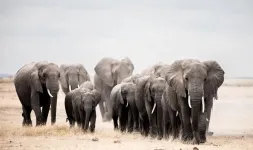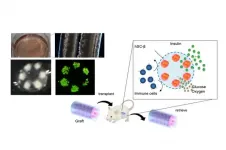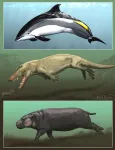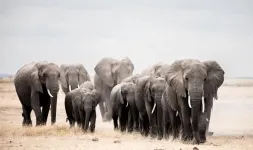(Press-News.org) A study reported in the journal Current Biology on April 1 has both good news and bad news for the future of African elephants. While about 18 million square kilometers of Africa--an area bigger than the whole of Russia--still has suitable habitat for elephants, the actual range of African elephants has shrunk to just 17%of what it could be due to human pressure and the killing of elephants for ivory.
"We looked at every square kilometer of the continent," says lead author Jake Wall of the Mara Elephant Project in Kenya. "We found that 62% of those 29.2 million square kilometers is suitable habitat."
The findings suggest that, if released from human pressures, including the threat of being killed for their ivory, elephants still have great potential for recovery into areas where the human footprint is light. They note that those 18 million square kilometers include many areas where there is still room for peaceful coexistence between humans and elephants as well as others where that prospect is clearly not realistic.
Like many wildlife species, it's long been clear that African elephant populations and their geographic range were shrinking due to killing for ivory, habitat loss, and the growth of human populations. But African savannah and forest elephants can live in many environments, from semi-deserts to tropical swamp forests. Wall's team wanted to better understand how elephants are using the space that's available to them and what's driving their ranging patterns.
To analyze the suitability of habitats over the entire continent at a kilometer-level scale, Wall and his colleagues drew on data from GPS-tracking collars fitted to 229 elephants across Africa by Save the Elephants and its partners over a 15-year period. Using Google Earth Engine, a satellite imagery computing platform, they looked at the vegetation, tree cover, surface temperature, rainfall, water, slope, aggregate human influence, and protected areas in the areas the elephants traversed. This allowed them to determine which habitats can support elephants and the extremes of conditions that they currently can tolerate.
"Combining three powerful tools--GPS telemetry, continent-wide remote sensing at a fine resolution, and a suite of analytical techniques--has allowed us to see what factors now control the movements and lives of these two hugely ecologically important species--and where, if circumstances change, they could range more widely across their historical African home," said Samantha Strindberg of the Wildlife Conservation Society.
The researchers uncovered vast areas of potentially suitable habitat for elephants in the Central African Republic and the Democratic Republic of Congo. The researchers note that forests in those areas recently held hundreds of thousands of elephants but today hold only about 5,000 to 10,000. The study also highlighted the extreme habitats that African elephants do not visit.
"The major no-go areas include the Sahara, Danakil, and Kalahari deserts, as well as urban centers and high mountaintops," said Iain Douglas-Hamilton, the founder of Save the Elephants. "That gives us an idea of what the former range of elephants might have been. However, there's a dearth of information about the status of African elephants between the end of Roman times and the arrival of the first European colonizers."
The tracking data also show that elephants living in protected areas tend to have smaller home ranges. The researchers suggest that's probably because they feel unsafe ranging into unprotected lands. The study notes that approximately 57% of the current elephant range is outside of protected areas, highlighting the limited space presently reserved for their safety. To secure long-term survival of elephants, the researchers say that habitat protection, protection of elephants themselves from illegal killing, and an ethic of human-elephant coexistence will be essential.
"Elephants are generalist mega-herbivores that can occupy fringe habitats," Wall says. "Their range may have shrunk, but if we gave them the chance, they could spread back to former parts of it."
Unfortunately, trends are headed in the wrong direction. "The human footprint is increasing at an accelerated rate and expected to double by 2050, with between 50% and 70% of the planet already experiencing anthropogenic disturbance," the researchers write. "Fragmentation of wildlife habitats by humans has resulted in only 7% of wildlife habitat patches being larger than 100 km2. Development scenarios that accommodate the spatial needs of wildlife leaving large, low-human impact areas of intact habitat, and especially formally protected areas, are urgently required. In the face of increasing human pressures, proactive landscape planning at the local, national, and continental scales are critical, as well as fostering an ethic of human elephant coexistence, if the future of elephants is to be secured."
INFORMATION:
This work was supported by the European Commission and a Canadian National Science and Research Council (NSERC) award. Please see paper for full acknowledgements.
Current Biology, Wall et al.: "Human footprint and protected areas shape elephant range across Africa" https://www.cell.com/current-biology/fulltext/S0960-9822(21)00381-X
Current Biology (@CurrentBiology), published by Cell Press, is a bimonthly journal that features papers across all areas of biology. Current Biology strives to foster communication across fields of biology, both by publishing important findings of general interest and through highly accessible front matter for non-specialists. Visit http://www.cell.com/current-biology. To receive Cell Press media alerts, contact press@cell.com.
Tokyo, Japan - Type I Diabetes Mellitus (T1D) is an autoimmune disorder leading to permanent loss of insulin-producing beta-cells in the pancreas. In a new study, researchers from The University of Tokyo developed a novel device for the long-term transplantation of iPSC-derived human pancreatic beta-cells.
T1D develops when autoimmune antibodies destroy pancreatic beta-cells that are responsible for the production of insulin. Insulin regulates blood glucose levels, and in the absence of it high levels of blood glucose slowly damage the kidneys, eyes and peripheral ...
A new study shows that the similarly smooth, nearly hairless skin of whales and hippopotamuses evolved independently. The work suggests that their last common ancestor was likely a land-dwelling mammal, uprooting current thinking that the skin came fine-tuned for life in the water from a shared amphibious ancestor. The study is published today in the journal Current Biology and was led by researchers at the American Museum of Natural History; University of California, Irvine; University of California, Riverside; Max Planck Institute of Molecular Cell Biology and Genetics; and the LOEWE-Centre for Translational Biodiversity Genomics (Germany).
"How mammals left terra firma and became fully aquatic is one of the most fascinating evolutionary ...
PHILADELPHIA -- (April 1, 2021 -- Scientists at The Wistar Institute identified a new mechanism of transcriptional control of cellular senescence that drives the release of inflammatory molecules that influence tumor development through altering the surrounding microenvironment. The study, published in Nature Cell Biology, reports that methyltransferase-like 3 (METTL3) and 14 (METTL14) proteins moonlight as transcriptional regulators that allow for establishment of the senescence-associated secretory phenotype (SASP).
Cellular senescence is a stable state of growth arrest in which cells stop dividing but remain viable and produce an array of inflammatory and growth-promoting molecules collectively defined as SASP. These molecules account ...
The University of Maryland (UMD) has collaborated with Cornell University and Stanford University to quantify the man-made effects of climate change on global agricultural productivity growth for the first time. In a new study published in Nature Climate Change, researchers developed a robust model of weather effects on productivity, looking at productivity in both the presence and absence of climate change. Results indicate a 21% reduction in global agricultural productivity since 1961, which according to researchers is equivalent to completely losing the last 7 years ...
ITHACA, N.Y. - Despite important agricultural advancements to feed the world in the last 60 years, a Cornell-led study shows that global farming productivity is 21% lower than it could have been without climate change. This is the equivalent of losing about seven years of farm productivity increases since the 1960s.
The future potential impacts of climate change on global crop production has been quantified in many scientific reports, but the historic influence of anthropogenic climate change on the agricultural sector had yet to be modeled.
Now, a new study provides these insights: "Anthropogenic Climate Change Has Slowed Global Agricultural Productivity ...
Many wildlife species are threatened by shrinking habitat. But according to new research, the potential range of African elephants could be more than five times larger than its current extent.
Due to 2,000 years of human pressure, African elephants have suffered dramatic population declines, and their range has shrunk to just 17% of what it could be, say researchers who led the new study, in Current Biology.
The dramatic reduction in range is due to the killing of elephants for their ivory and the encroachment of humans into elephant habitat. Evidence for elephants being ...
Children hospitalized with breathing problems due to a common viral lung infection are likely to get sicker and remain hospitalized if they have high levels of defective copies of the virus, according to a new study by researchers at Washington University School of Medicine in St. Louis.
The findings, published April 1 in Nature Microbiology, could help doctors identify those patients at high risk of severe illness due to respiratory syncytial virus (RSV), the most common cause of pneumonia and bronchiolitis (inflammation of the small airways) in children under age 5.
"Every ...
What The Study Did: This observational study examined death and hospital readmission rates of patients with COVID-19 pneumonia after being discharged to home or quarantine housing with supplemental home oxygen.
Authors: Brad Spellberg, M.D., of the Los Angeles County + University of Southern California Medical Center in Los Angeles, is the corresponding author.
To access the embargoed study: Visit our For The Media website at this link https://media.jamanetwork.com/
(doi:10.1001/jamanetworkopen.2021.3990)
Editor's Note: Please see the article for additional information, including other authors, author contributions and affiliations, conflict of interest ...
What The Study Did: Researchers assessed changes in the number of views of articles published in three leading medical journals since the start of the COVID-19 pandemic.
Authors: Andrew J. Giustini, M.D., Ph.D., of the Stanford University School of Medicine in Stanford, California, is the corresponding author.
To access the embargoed study: Visit our For The Media website at this link https://media.jamanetwork.com/
(doi:10.1001/jamanetworkopen.2021.6459)
Editor's Note: Please see the article for additional information, including other authors, author contributions and affiliations, conflict ...
What The Study Did: Nationally representative data were used to look at whether systolic and diastolic blood pressure levels among children and adolescents in the United States have changed during the past 20 years.
Authors: Shakia T. Hardy, Ph.D., of the University of Alabama at Birmingham, is the corresponding author.
To access the embargoed study: Visit our For The Media website at this link https://media.jamanetwork.com/
(doi:10.1001/jamanetworkopen.2021.3917)
Editor's Note: The article includes conflicts of interest and funding/support disclosures. Please see the ...





